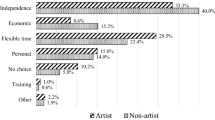Abstract
Recent research has highlighted ways in which the labour market behaviour of artists differs from the predictions of conventional theory. This paper considers one particular aspect of artists’ labour supply, i.e. the extent to which preferred time allocations to creative work can be realised, given the multiple job-holding and other characteristics of artists’ working arrangements. It is suggested that greater financial security and the accumulation of human capital are likely to be associated with increased ability to achieve equilibrium between desired and actual labour supply to the market for creative work. These propositions are tested empirically using data from a recent survey of practising professional artists in Australia.
Similar content being viewed by others
References
Abbing, H. 2002.Why Are Artists Poor? The Exceptional Economy of the Arts. Amsterdam: Amsterdam University Press.
Alper, N.O. and G. H. Wassail. 2006. “Artists’ Careers and Their Labor Markets.” in Ginsburgh and Throsby (eds) 2006.
Benhamou, F. 2000. “The Opposition between Two Models of Labour Market Adjustment: The Case of Audiovisual and Performing Arts Activities in France and Great Britain over a Ten Year Period.”Journal of Cultural Economics 24: 301–319.
Caves, R.E. 2000.Creative Industries: Contracts between Art and Commerce. Cambridge: Harvard University Press.
Cowen, T. and A. Tabarrok. 2000. “An Economic Theory of Avant-Garde and Popular Art, or High and Low Culture.”Southern Economic Journal 67: 232–253.
Filer, R.K. 1989. “The Economic Condition of Artists in America.” in D. V. Shaw et al. (eds.), 1989.Cultural Economics 88: An American Perspective. Akron: Association for Cultural Economics.
Ginsburgh, V. and D. Throsby (eds.) 2006.Handbook of the Economics of Art and Culture. Amsterdam: Elsevier/North Holland.
Heikkinen, M. 1995. “Evaluating the Effects of Direct Support on the Economic Situation of Artists.”Journal of Cultural Economics 19: 261–271.
Jeffri, J. and R. Greenblatt. 1998.Information on Artists: A Study of Artists’ Work-Related Human and Social Service Needs in Four U.S. Locations. New York: Research Center for Arts and Culture, Columbia University.
Karhunen, P. (1998), “Labour Market Situation of Graduated Artists.” in M. Heikkinen and T. Koskinen (eds.),Economics of Artists and Arts Policy. Helsinki: Arts Council of Finland.
Menger, P.M. 2006. “Artistic Labor Markets: Contingent Work, Excess Supply and Occupational Risk Management.” in Ginsburgh and Throsby (eds.) 2006.
Rengers, M. 2002.Economic Lives of Artists: Studies into Careers and the Labour Market in the Cultural Sector. Utrecht: Utrecht University, Interuniversity Center for Social Science Theory and Methodology.
Robinson, M.D. and S.S. Montgomery. 2000. “The Time Allocation and Earnings of Artists.”Industrial Relations 39: 525–534.
Throsby, D. 1992. “Artists as Workers.” in Towse and Khakee (eds.)Cultural Economics. Heidelberg: Springer-Verlag.
Throsby, D. 1994a. “A Work-Preference Model of Artist Behaviour.” in A. Peacock and I. Rizzo (eds.) 1994.Cultural Economics and Cultural Policies. Dordrecht: Kluwer Academic Publishers.
Throsby, D. 1994b. “The Production and Consumption of the Arts: A View of Cultural Economics.”Journal of Economic Literature 32: 1–29.
Throsby, D. 1996. “Disaggregated Earnings Functions for Artists.” in V. Ginsburgh and P.M. Menger (eds.) 1996.Economics of the Arts: Selected Essays. Amsterdam: North Holland.
Throsby, D. and V. Hollister. 2003.Don’t Give Up Your Day Job: An Economic Study of Professional Artists in Australia. Sydney: Australia Council.
Towse, R. and A. Khakee (eds.), 1992.Cultural Economics. Heidelberg: Springer-Verlag.
Towse, R. 2006. “Human Capital and Artists’ Labour Markets.” in Ginsburgh and Throsby (eds.) Amsterdam: Elsevier/North Holland.
Wassail, G.H. and N.O. Alper. 1992. “Towards a Unified Theory of the Determinants of the Earnings of Artists.” in Towse and Khakee (eds.) 1992.
Author information
Authors and Affiliations
Corresponding author
Rights and permissions
About this article
Cite this article
Throsby, D. Preferred work patterns of creative artists. J Econ Finan 31, 395–402 (2007). https://doi.org/10.1007/BF02885729
Issue Date:
DOI: https://doi.org/10.1007/BF02885729




